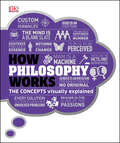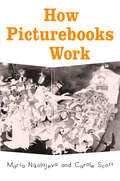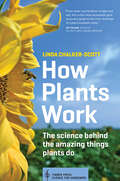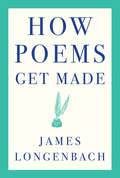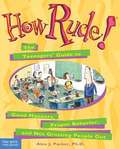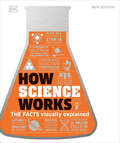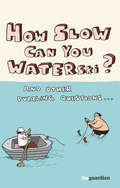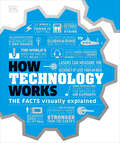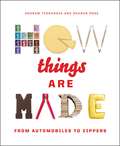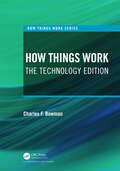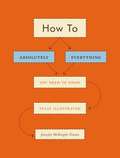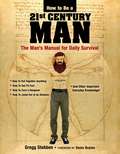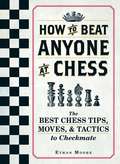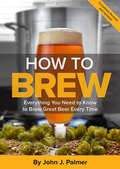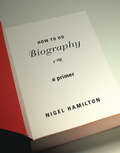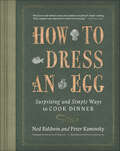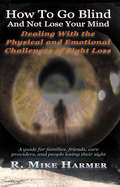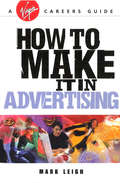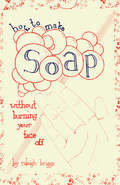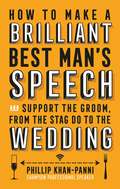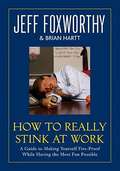- Table View
- List View
How Philosophy Works: The Concepts Visually Explained (DK How Stuff Works)
by DKWhat is the meaning of life? Are we truly free? How can we make ethical choices? Discover the answers to life's greatest questions.Demystifying the key ideas of the world's greatest philosophers, and exploring all of the most important branches of philosophical thought in a uniquely visual way, this book is the perfect introduction to the history of philosophy. How Philosophy Works combines bold infographics and jargon-free text to demystify fundamental concepts about the nature of reality. Covering everything from ethics to epistemology and phenomenology, the book presents the ideas and theories of key philosophical traditions and philosophers - from Plato and Socrates to Nietzsche and Wittgenstein via Kant - in a novel, easy-to-understand way. Its infographics will help you to understand the elements of philosophy on a conceptual level and, by tackling life's "big questions", it will help you to look at the world in an entirely new way. With its unique graphic approach and clear, authoritative text, How Philosophy Works is the perfect introduction to philosophy, and the ideal companion to DK's The Philosophy Book in the "Big Ideas" series.
How Picturebooks Work (Children's Literature and Culture #14)
by Maria Nikolajeva Carole ScottHow Picturebooks Work is an innovative and engaging look at the interplay between text and image in picturebooks. The authors explore picturebooks as a specific medium or genre in literature and culture, one that prepares children for other media of communication, and they argue that picturebooks may be the most influential media of all in the socialization and representation of children. Spanning an international range of children's books, this book examine such favorites as Curious George and Frog and Toad Are Friends, along with the works of authors and illustrators including Maurice Sendak and Tove Jansson, among others. With 116 illustrations, How Picturebooks Work offers the student of children's literature a new methodology, new theories, and a new set of critical tools for examining the picturebook form.
How Plants Work: The Science Behind the Amazing Things Plants Do (Science For Gardeners Ser.)
by Linda Chalker-ScottThe more you know, the better you grow! Plants are capable of interesting and unexpected things. Why do container plants wilt when they’ve been regularly watered? Why did the hydrangea that thrived last year never bloom this year? Why do slugs wipe out the vegetable garden instead of eating the weeds? Plant physiology—the study of how living things function—can solve these and most other problems gardeners regularly encounter.In How Plants Work, horticulture expert and contributor to the popular blog The Garden Professors, Linda Chalker-Scott brings the stranger-than-fiction science of the plant world to vivid life. She uncovers the mysteries of how and why plants do the things they do, and arms the home gardener with fascinating knowledge that will change the way they garden.
How Poems Get Made
by James LongenbachA comprehensive guide to writing or reading poetry, by “one of our most lucid and important critics” (American Academy of Arts and Letters). Why does a great lyric poem ask to be reread, even after we know it by heart? In How Poems Get Made, acclaimed poet and critic James Longenbach answers this question by discussing a wide range of exemplary poems, from Shakespeare through Blake, Dickinson, and Moore, to a variety of poets making poems today. In each chapter of How Poems Get Made, Longenbach examines a specific aspect of the poetic medium—including Diction, Syntax, Rhythm, Echo, Figure, and Tone—and shows how a poet may manipulate these most basic elements to bring a poem to life.
How Rude! The Teenagers' Guide to Good Manners, Proper Behavior, and Not Grossing People Out
by Alex J. PackerHere's an etiquette book that teens will want to read--because it keeps them laughing, doesn't preach, and deals with issues that matter to them, as teens themselves reported in a nationwide survey. In How Rude!, author Alex J. Packer blends outrageous humor with sound advice as he guides readers through the mysterious world of manners from A ("Applause") to Z ("Zits"). He starts by explaining why etiquette is important--because people who know how to handle themselves in social situations come out on top, get what they want, feel good about themselves, and enjoy life to the fullest. Fourteen chapters describe the basics of polite behavior in all kinds of situations at home, in school, and in the world. Teens learn how to be a host with the most (and a guest with the best), what to do (and not do) when going online or waiting in line, how to deal with rude relatives, how to act at the mall and the concert hall, how to make introductions, who invented manners, and much more. Hundreds of "Dear Alex" questions and answers cover everything from dating to breaking up, thank-you notes to table manners, ethnic jokes to social cliques, skateboarding to celebrating. Survey results reveal what teens, parents, and teachers think about manners and why they're important. Full of practical tips for every occasion, How Rude! is a serious etiquette encyclopedia--and a hilarious read.
How Science Works: The Facts Visually Explained (DK How Stuff Works)
by DKThis visual guide is packed with amazing diagrams and infographics to answer all your burning scientific head-scratchers - from gravity and black holes to earthquakes and gene therapy. In How Science Works you will find the most fascinating phenomena in the Universe visually explained, from pulleys to string theory, light to lasers, and chemical reactions to artificial intelligence. If you have ever wondered why the sky is blue, how a black hole works, or what happens in a tsunami, this indispensable guide is for you. Rather than long columns of text, How Science Works is filled with diagrams and infographics, to make even the most difficult concept fun and easy to grasp. Turn the pages to understand dark matter, radioactivity and so much more, and find answers to the really big questions including how life began, will the Universe end, and are we really alone? With hours of enthralling reading, How Science Works is the book you wished you'd had at school and it's the one you'll want for your family.
How Slow Can you Waterski?: and other puzzling questions ...
by Guardian News and Media LtdWhen the powers that be reduced the speed limit on Lake Windermere to 10 knots, waterskiers complained that their sport was now completely scuppered. So just how slow can you waterski before you start to sink beneath the waves?And, while we're about it, how long can you survive in a freezer? What are the chances of being struck by lightning in bed? And why is it so esay to raed wrods eevn wehn the lteetrs are mdduled up?Everyday life can pose some mind-boggling questions - but where do you find the answers? The Guardian's popular 'This Week' column has been looking into the science behind the news for three years, and How Slow Can You Waterski? draws together a selection of the most imaginative questions and the most surprising answers. If you've ever wondered what makes a planet a planet, why submarines keep bumping into things or even if it's safe to eat mud, How Slow Can You Waterski? will prove irresistible - and enlightening - reading.
How Technology Works: The Facts Visually Explained (DK How Stuff Works)
by DKHave you ever asked yourself how the inventions, gadgets, and devices that surround us actually work? Discover the hidden workings of everyday technology with this graphic guide.How Technology Works demystifies the machinery that keeps the modern world going, from simple objects such as zip fasteners and can openers to the latest, most sophisticated devices of the information age, including smartwatches, personal digital assistants, and driverless cars. It includes inventions that have changed the course of history, like the internal combustion engine, as well as technologies that might hold the key to our future survival, including solar cells and new kinds of farming to feed a growing population. Throughout the book, step-by-step explanations are supported by simple and original graphics that take devices apart and show you how they work. The opening chapter explains principles that underpin lots of devices, from basic mechanics to electricity to digital technology. From there, devices are grouped by application--such as the home, transportation, and computing--making them easy to find and placing similar devices side by side. How Technology Works is perfect for anyone who didn't have training in STEM subjects at school or is simply curious about how the modern world works.
How Things Are Made: From Automobiles To Zippers
by Andrew TerranovaFor anyone curious about the nuts and bolts of human ingenuity, How Things Are Made is a fascinating exploration of the process behind the manufacture of everyday items.What are bulletproof vests made of? How do manufacturers get lipstick into the tube? How many layers are there in an iPhone screen? The answers to these questions and so much more fascinating information can be found in How Things Are Made, a behind-the-scenes look at the production everyday objects of all kinds, from guitars, sunscreen, and seismographs to running shoes, jet engines, and chocolate.Thoroughly revised and redesigned from the best-selling 1995 edition, How Things Are Made also contains three new entries by author Andrew Terranova. However, each page still contains informative step-by-step text along with detailed but easy-to-follow illustrations, diagrams, and sidebars to tell the stories behind the things we sometimes take for granted. For example, did you know that Edison didn't really invent the light bulb? Or that the first bar code was on a pack of Wrigley's Spearmint gum? Or that a maple seed inspired the design for the helicopter? Discover these fascinating anecdotes and much more in How Things Are Made.
How Things Work: The Technology Edition (How Things Work Series)
by Charles F. BowmanIt is beyond trite to say that technology is prevalent in our daily lives. However, many of us remain clueless as to how much of it works. Unfortunately, even for the curious among us, the Web is not always the best vehicle to acquire such knowledge: Information appears in fragments, some of it is incorrect or dated, and much of it serves as jargon-laden discussions intended for professionals. How Things Work: The Technology Edition will serve as a compendium of tutorials. Each section will focus on one technology or concept and provide the reader with a thorough understanding of the subject matter. After finishing the book, readers will understand the inner workings of the technologies they use every day and, more importantly, they will learn how they can make these tools work for them. In addition, the book will also inform readers about the darker side of modern technology: Security and privacy concerns, malware, and threats from the dark web.
How To
by Jennifer Mcknight-TrontzA delightful visual compendium and very nearly a substitute for good common sense, How To is the silly and seriously useful guide to mastering the miscellany of modern life. Packed in this chunky little volume are hundreds of instructional diagrams, culled from vintage how-to books, manuals, and product packaging, illustrating how to do anything you'll ever need to do--and many things you won't. With a bare minimum of text and just a few action arrows, these hard-working graphics are here to help. Learn how to use chopsticks, breakdance, tie a trash bag, diaper a baby, and parallel park. Discover the right way to do a cartwheel, use dental floss, hammer a nail, and slice bread. And if you've ever wondered whether you were walking correctly, wonder no more. With chapters to help you navigate the daily concerns of manners and grooming, home and family, health and safety, sports and exercise, and science and the world at large, this pocket-sized primer is the only book you'll ever really need. Honest.
How To Be a 21st Century Man: The Man's Manual for Daily Survival
by Denis Boyles Gregg StebbenHow to Be a 21st Century Man is more than just a how-to guide; it is an essential life-tool that every man should have at his disposal. With time-saving, life-improving tips, it is the premier guide to manliness. Featured within are sections on incredibly important issues in a man’s life, including:How to Read Lights On Your Car’s DashboardHow to Buy a SuitHow to Tell if a Woman Likes YouHow to Mix a Martini Like James BondHow to Live ForeverAnd Much More!If you are a college graduate just entering the "real” world, or just a guy who never learned how to change a car battery or how to groom yourself properly, this manual to manhood should be within reach at all times.
How To Beat Anyone At Chess: The Best Chess Tips, Moves, and Tactics to Checkmate
by Ethan MooreLearn to take the king like a pro!Whether you've played a few matches or are completely new to the game, How to Beat Anyone at Chess helps you master leading strategies for one of the hardest games out there. Each page guides you through important moves with easy-to-understand explanations and tips for staying ahead of your opponent. From utilizing the queen's power to slaying your rival's king, you'll learn all about the traps, squeezes, and sacrifices that give players an extra edge and how you can use these techniques to beat the competition.The ultimate guide to conquering the classic game, How to Beat Anyone at Chess will show you how to become a grandmaster in no time!
How To Brew: Everything You Need to Know to Brew Great Beer Every Time
by John J. PalmerHow to Brew is the definitive guide to making quality beers at home. Whether you want simple, sure-fire instructions for making your first beer, or you&’re a seasoned homebrewer working with all-grain batches, this book has something for you. John Palmer adeptly covers the full range of brewing possibilities—accurately, clearly and simply. From ingredients and methods to recipes and equipment for brewing beer at home, How to Brew is loaded with valuable information on brewing techniques and recipe formulation.A perennial best seller since the release of the third edition in 2006, How to Brew, is a must-have to update every new and seasoned brewer&’s library.This completely revised and updated edition includes:More emphasis on the &“top six priorities&”: sanitation, fermentation temperature control, yeast management, the boil, good recipes, and water.Five new chapters covering malting and brewing, strong beers, fruit beers, sour beers, and adjusting water for style.All other chapters revised and expanded:Expanded and updated charts, graphs, equations, and visuals.Expanded information on using beer kits.Thorough revision of mashing and lautering chapters:Expanded tables of recommended times and temperatures for single-infusion, multiple-step, and decoction mashing.Complete discussion of first wort gravity as a function of water to grist ratio.Complete revision of infusion and decoction equations.Revised and updated information on managing your fermentation:Yeast pitching and starters. Yeast starter growth factors.Yeast and the maturation cycle.And much more!
How To Clean Everything: The Authoritative Guide to Cleaning, Conditioning and Stain Removal for Every Type of Material and Surface (3rd Edition)
by Alma Chesnut MooreFrom the book: HOW TO CLEAN EVERYTHING is a comprehensive guide to cleaning any material, removing any stain and caring for any object. This manual, now available from JOB SQUAD, will become so indispensable, you will wonder how you ever managed to clean a home without it! Among the hundreds of tips offered are: Remove chewing gum (if water does not spot the material) by rubbing the gummy portion with a piece of ice. Then you can scrape or rub the gum out of the fabric. Clean a diamond ring by boiling mild soapsuds with a few drips of ammonia added, immersing the ring, dipping it into a small bowl of alcohol, and letting it dry on tissue paper. Remove fresh coffee and tea stains (if it's safe for the fabric) by stretching the stained portion of cloth over an open bowl and securing it with a rubber band. From a height of 1 to 3 feet, pour boiling water over the cloth. From awnings to Venetian blinds, cashmere to silk, coral to vinyl, HOW TO CLEAN EVERYTHING provides the best methods for ensuring a long and beautiful life for your belongings.
How To Do Biography: A Primer
by Nigel HamiltonIt is not surprising that biography is one of the most popular literary genres of our day. What is remarkable is that there is no accessible guide for how to write one. Now, following his recent Biography: A Brief History (from Harvard), award-winning biographer and teacher Nigel Hamilton tackles the practicalities of doing biography in this first succinct primer to elucidate the tools of the biographer’s craft. Hamilton invites the reader to join him on a fascinating journey through the art of biographical composition. Starting with personal motivation, he charts the making of a modern biography from the inside: from conception to fulfillment. He emphasizes the need to know one’s audience, rehearses the excitement and perils of modern research, delves into the secrets of good and great biography, and guides the reader through the essential components of life narrative. With examples taken from the finest modern biographies, Hamilton shows how to portray the ages of man—birth, childhood, love, life’s work, the evening of life, and death. In addition, he suggests effective ways to start and close a life story. He clarifies the difference between autobiography and memoir—and addresses the sometimes awkward ethical, legal, and personal consequences of truth-telling in modern life writing. He concludes with the publication and reception of biography—its afterlife, so to speak. Written with humor, insight, and compassion, How To Do Biography is the manual that would-be biographers have long been awaiting.
How To Dress An Egg: Surprising and Simple Ways to Cook Dinner
by Peter Kaminsky Ned Baldwin“This collection of varied and delicious suggestions for dressing up basic key recipes is recommended for home cooks looking to add some flair to . . . meals.” —Library JournalLearn to cook one thing exceptionally well and you open the door to a multitude of possibilities, with no need for special equipment or fussy techniques.Ned Baldwin, a home cook who taught himself to be an excellent chef, sees no reason why anyone else can’t do the same. By showcasing one ingredient per method, Baldwin introduces all the skills a cook will ever need to prepare endless pleasurable meals. Get a big, beefy hit from a hanger steak by cooking it in the oven; master salad-making with leafy greens; grill fillets of sea bass for crispy skin and moist flesh; roast an explosively juicy chicken; bake leeks to soft perfection; and more.Each dish is elaborated on in different ways to expand the technique into unlikely, inventive recipes that are jumping-off points for endless creativity.“One has to cook with precision and confidence to pull off ‘simple’ cooking. Ned’s common sense approach is evident on every page.” —Tom Colicchio James Beard award–winning chef and Emmy-award winning producer of Top Chef“This book will make you hungry and happy.” —Ruth Reichl, James Beard award–winning food writer and editor and chief of Gourmet magazine “Keep this book close—you’ll be consulting it often.” —Dorie Greenspan, James Beard award–winning author of Everyday Dorie“A secret treasure, full of tweaks and twists for rendering familiar-seeming dishes into delicious food.” —Bill Buford, national bestselling author of Heat “Instills confidence, and even injects a bit of fun into the food preparation.” —Booklist
How To Go Blind and Not Lose Your Mind: Physical and Emotional Challenges of Sight Loss
by Mike HarmerHow To Go Blind And Not Lose Your Mind discusses the process of losing your sight and ways to deal with it. Written through the eyes of a person who has been through the process and survived. How To Go Blind And Not Lose Your Mind begins at the diagnosis, walks you through the stages of sight loss, and explores emotional and physical problems associated with going blind. It describes low vision, legal blindness, loss of independence, and what it may mean to you. You will find what help and visual aids are available. There are physical and emotional problems with loss of sight, however you can still keep your vision about living and enjoy a full, happy life. This book gives more than just hope, it is the vision you need while losing your sight.
How To Haiku? A Haiku Guidebook For The Practically Confused Soul
by Kaushal Suvarna"How to Haiku? A haiku guidebook for the practically confused soul" by Kaushal Suvarna is a comprehensive journey into the art of haiku, aiming to demystify its complexities for both newcomers and those seeking deeper insights. Beginning with an introduction that sets the stage for understanding haiku's essence, the book delves into its essential elements like kireji, kigo, and the 5-7-5 syllable structure, while also addressing contemporary interpretations in English. Through insightful discussions on writing techniques, such as scene-setting, character focus, and juxtapositions, readers are equipped with the tools to craft evocative haiku. Practical exercises supplemented with examples further enhance understanding and skill development. Emphasizing the importance of simplicity and clarity in conveying profound emotions and universal truths, the book encourages readers to embark on their own unique haiku-writing journey, guiding them towards finding their authentic voice within this timeless art form.
How To Live Like A Lady: Lessons in Life, Manners, and Style
by Sarah TomczakWhat makes a lady? It's what the French (who know about these things) call je ne sais quoi. It's a certain something that results from the delicate combination of elegance, charm, and wit. No matter how good looking, wealthy, or accomplished a woman might be, she isn't living the life of a lady until she behaves like one. How to Live Like a Lady is a handbook that will guide any woman, manicured hand in manicured hand, to a lifestyle of manners, style, and elan.
How To Make It In Advertising
by Mark LeighAdvertising. Is it really 'the greatest art form of the twentieth century' (Marshall McLuhan)? Whatever your views, it is undeniably one of the most popular career choices going-and one of the most difficult to get into. If you want to be creative and make money, or simply fancy trying your handat a job in one of the most powerful industries around, then this indispensable guide is all you'll need to get a foot in the door and keep a step ahead of the competition. It's a careers guide with a difference, using the experience and wisdom of some of the industry's top people. You'll find essential advice on how to get started and how to get ahead, as well as the insider's view of the genuine pros and cons of each job, from copywriter to account handler. Your new career starts here.
How To Make Soap: Without Burning Your Face Off
by Raleigh BriggsRaleigh Briggs, author of the popular Microcosm title Make Your Place, is back with another pamphlet on better, healthier living. This time around, she tackles soap-making basics, and teaches us how to create silky handmade soaps at home.<P><P> How To Make Soap contains basic directions, recipes, a list of resources, and assorted tips and tricks to make your homemade soaps special. Raleigh takes a seemingly arduous task, and makes it breezy and fun, with her charming hand-drawn illustrations and easy to follow directions. How to Make Soap is a great guide (and gift!) for the beginning soapmaker, looking for a place to start.<P><P> Advisory: Bookshare has learned that this book offers only partial accessibility. We have kept it in the collection because it is useful for some of our members. To explore further access options with us, please contact us through the Book Quality link on the right sidebar. Benetech is actively working on projects to improve accessibility issues such as these.
How To Make a Brilliant Best Man's Speech: and support the groom, from the stag do to the wedding
by Phillip Khan-PanniHow to make a great, best man's speech - and a guide to being a great best man.In this book Phillip Khan-Panni uses his expertise as a champion professional speaker to help the best man with the terrifying prospect of writing and delivering The Speech.He guides you on the vital preparation of your speech and tells you how to use stories, jokes and quotations that will lift it well above the bare necessities. With the author`s help and his professional tips and techniques, you will be able to make a really entertaining and moving speech that will be remembered for a long time to come. You might even enjoy making it as much as the guests do hearing it!There are also checklists and further advice to help you organise the whole occasion so that the big day honours the groom and his bride and thoroughly impresses their friends and relations
How To Make a Brilliant Best Man's Speech: and support the groom, from the stag do to the wedding
by Phillip Khan-PanniHow to make a great, best man's speech - and a guide to being a great best man.In this book Phillip Khan-Panni uses his expertise as a champion professional speaker to help the best man with the terrifying prospect of writing and delivering The Speech.He guides you on the vital preparation of your speech and tells you how to use stories, jokes and quotations that will lift it well above the bare necessities. With the author`s help and his professional tips and techniques, you will be able to make a really entertaining and moving speech that will be remembered for a long time to come. You might even enjoy making it as much as the guests do hearing it!There are also checklists and further advice to help you organise the whole occasion so that the big day honours the groom and his bride and thoroughly impresses their friends and relations
How To Really Stink At Work
by Jeff Foxworthy Brian Hartt"New York Times"-bestselling humorist Foxworthy offers a hilarious, illustrated guide to having the most fun possible at work while doing the least--without getting fired. Illustrations throughout.
